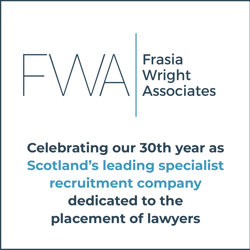Stepping Up
The Journal spoke to new president, Susan Murray, on building her career from a level playing field and the importance of representing the Society and its members.

Susan’s approach has been – and will continue to be – important in her career. Although initially deciding to study English at an English university, she ultimately opted for law at the University of Edinburgh. “I realised that I was keen to study a vocational course – something completely new that I hadn’t studied before. It was exciting to start a subject where everyone began on a level playing field and we were becoming lawyers together,” she explains.
Building a career
Susan, who has worked in-house for NHS Scotland for nearly 40 years and has for a long time specialised in medical negligence, starting off working exclusively on a hospital building contract dispute. “What appealed to me was that it was then a niche area of legal practice with what turned out to be a lot of autonomy for a young lawyer. That really makes you up your game quickly,” she says.
“I also found that I thrived in a situation where I was working with a range of fellow professionals in the building industry and subsequently in healthcare. It’s that collegiality of approach to finding successful outcomes that has always kept work feeling fresh for me.”
Since 2008 Susan has mostly been instructed in long-running public inquiries, including the Penrose Inquiry in Scotland and the UK Infected Blood Inquiry. She has now come full circle within her career, back to building issues, with her work on the Scottish Hospitals Inquiry.
She adds: “The reason I’ve stayed so long is that it’s an inherently interesting job, which covers a huge range of legal issues. Also, I feel passionate about supporting the organisations and individuals at the heart of NHS Scotland.”
It’s also this mindset that led Susan to become a trade union representative within the Scottish Health Service’s Central Legal Office. “It’s an extension of what solicitors do – advise and support people and advocate on their behalf,” she says. “It seemed like a natural progression for me within my workplace – and happily the NHS is very much grounded on positive ‘partnership working’ between managers and staff.”
Changes in the profession
Developments in technology, flexibility and legal processes are just some of the changes Susan has witnessed during the past four decades.
In terms of flexibility of working arrangements, she explains: “There has certainly been a revolution during my career, with significant increases in flexible working now allowing many solicitors to achieve the work-life balance that they are looking for – which keeps them in the profession for their full career.”
Susan herself is part of a major milestone. For the first time in the Law Society of Scotland’s history, there are women in all three presidential positions – past, current and vice president.
Supporting women and diversity within the profession is an area that Susan wants to continue to build on, having convened the Society’s Equality and Diversity Committee since 2018. Interestingly, this was when the Profile of the Profession survey revealed that although more women were entering the legal sector than men, more of them were leaving mid-career. “That’s something that we in the Society are busy working on – the future sustainability of the profession,” Susan says.
One aspect of this involves equality and diversity training. “I recently attended an excellent Equality, Diversity and Inclusion Certification Course put together by the Society and Diversity+ [a leading diversity and inclusion consultancy]. This was a pilot for courses that we want to run more frequently, with much larger numbers of leaders and managers within the profession attending,” she explains.
“It’s not only about what we can do in terms of highlighting these issues – we want to offer accredited training courses, which can help solicitors achieve career choices that work for them. We would like to see all organisations who employ lawyers get more involved in this key area for recruitment and retention of a stable legal workforce.”
A focus on people
It was partly intrigue that got Susan involved with the Society. “I reached an age and stage where I thought, this is my professional body, I have been a member since 1984, yet I don’t know a great deal about what it does and how it works for the profession,” she says.
Susan was first elected to the Society’s Council to represent Edinburgh constituency members in 2017. Having joined a working group on Society Governance during her first year on Council, and then convened the Equality and Diversity Committee before joining the Board, she says: “It’s like swimming out to sea – you are drawn in deeper and deeper.”
In the year ahead, Susan is eager to meet people. “That’s one of the key reasons I stood for election as President of the Society,” she explains. “We often live in our own bubble in terms of the types of law we work with and the types of organisations we work for. I’m looking forward to expanding my own professional horizons and encouraging all members to appreciate the depth and breadth of their Society’s membership.”
Susan wants to know more about the challenges that firms and organisations that employ solicitors are facing. “I want to understand more about the pressures, assess what is being done already and work on what more we can all do to relieve those pressures,” she says.
Bringing the profession together
However, it’s not just representing the profession within Scotland that Susan wants to focus on. “It’s crucial for the Society’s members to be part of the global legal community. Even in the past few months we have experienced how important it is to be able to harness support from our global colleagues in the International Bar Association. It turns out that legal services regulation is an issue right across the world,” she adds.
The Regulation of Legal Services (Scotland) Bill will be a key part of Susan’s presidential year. “What currently lies ahead is the phase where the Bill becomes legislation. After that we will have the challenge of making the changes work,” she explains. “This will likely be an important part of my day-to-day workload.”
In terms of advancing the profession further, she adds: “Personally, I will do what I can to bring the membership together.” For her, key to this is sharing ideas. “We can all benefit from each other’s knowledge,” Susan adds. “I know it’s going to be a fast year, but I am looking forward to meeting as many members as I can, to understand their issues and work to improve their experience.”
Susan’s top tips for solicitors
For new solicitors, Susan says: “Make sure you find work that you enjoy doing and that challenges you. Work in a place where you know you are valued.”
For new members of the Society, she adds: “Get involved – join the Society’s committees in your area of work or in other areas that interest you. It’s a great way to learn about the legal profession you are part of and get to know your professional colleagues throughout Scotland and beyond. Also think about joining Council and becoming a Society Office Bearer yourself!”
Written by Katie Smith, writer
Photograph by Jamie Williamson






